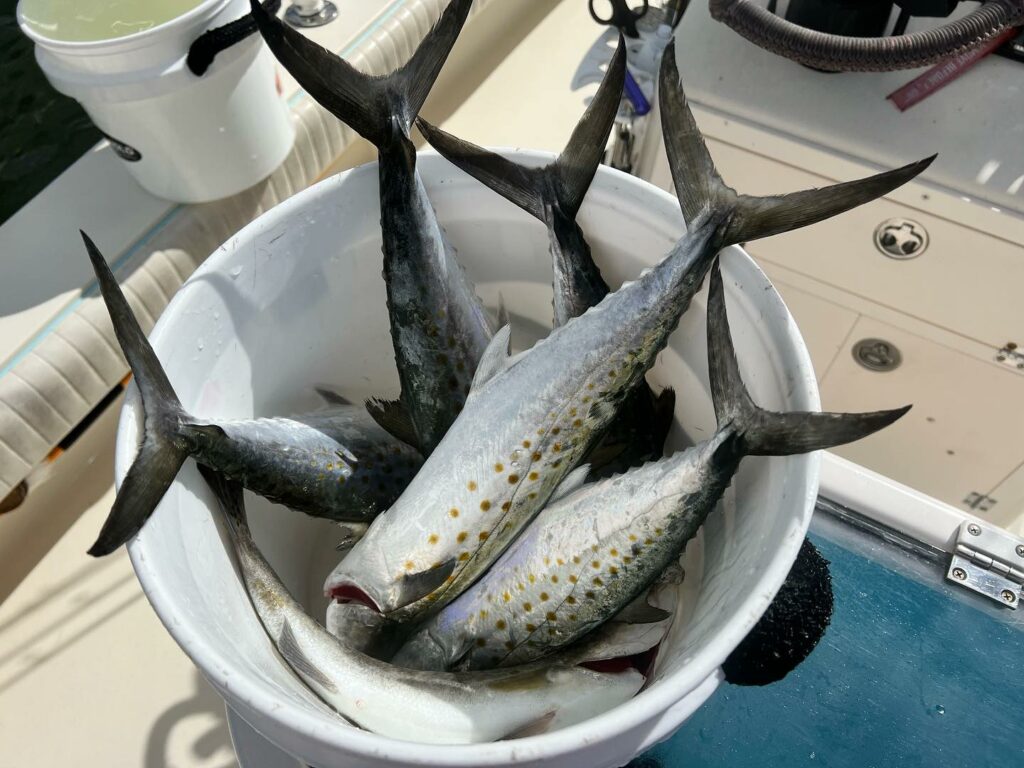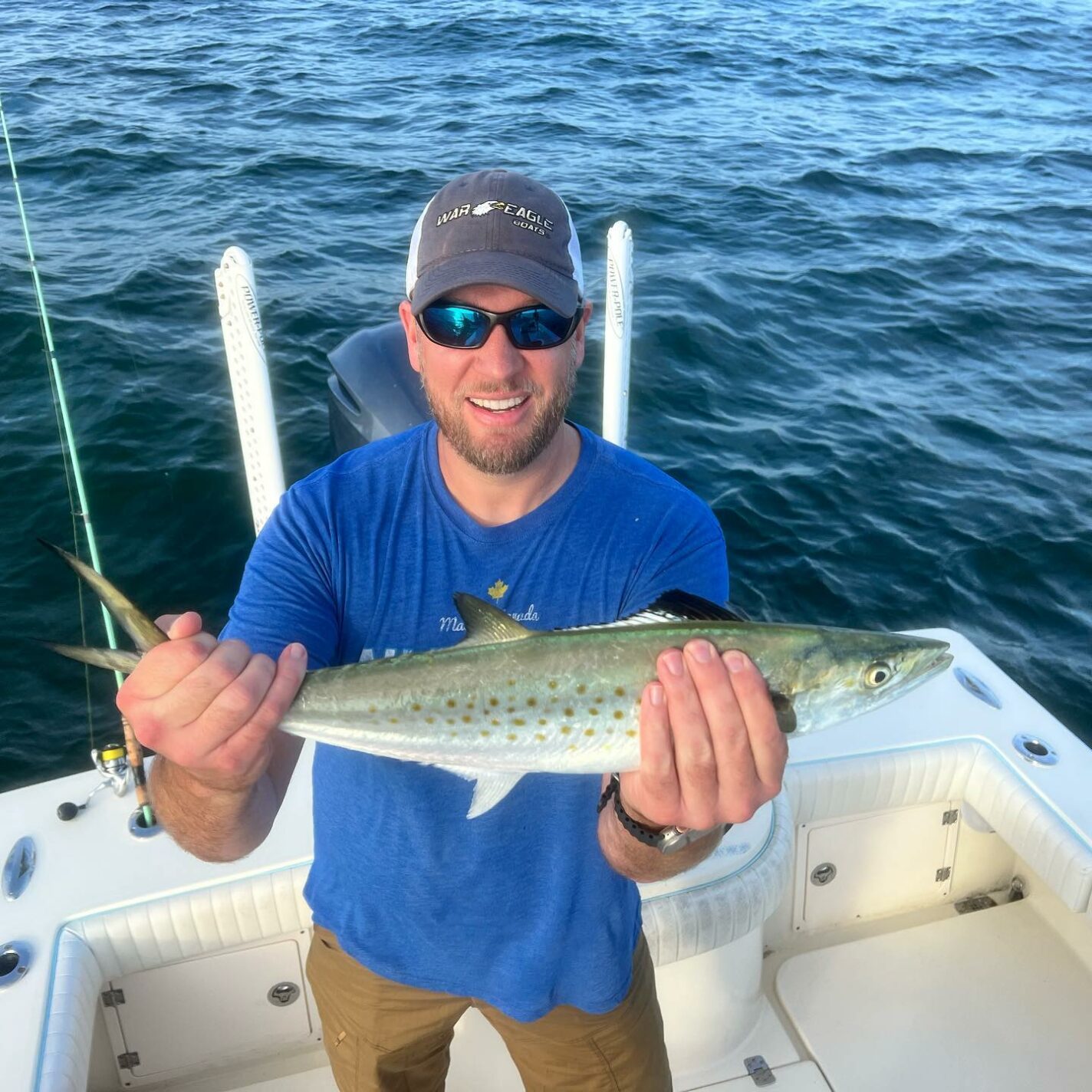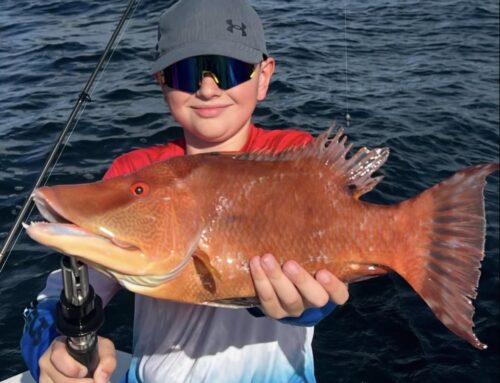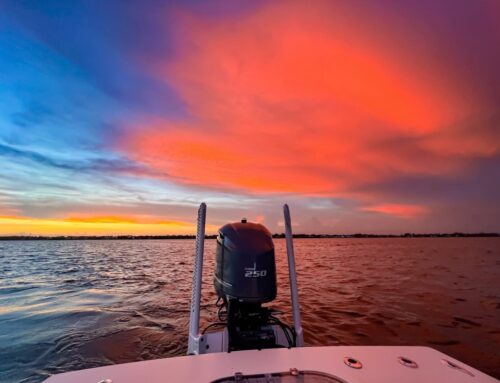Last Updated on September 23, 2025 by Writer
The transition into fall between September and November changes everything about inshore fishing around Anna Maria Island. The blazing summer heat begins to subside, surface water temperatures fall steadily, and a series of bait migrations reshapes the entire fishery. Schools of mullet surge through the passes, pilchards gather in tighter shoals, and shrimp begin their nighttime journeys, all attracting predators that crowd into the bays, flats, and shorelines. Northerly winds push tides higher against mangrove edges, then sweep water out with strength, exposing oyster bars and sandy potholes that become hot feeding zones. For fishermen, this is the moment when species overlap peaks. Snook, redfish, trout, mackerel, pompano, sheepshead, and more are all active, often in the same general areas. The only dividing line is State Road 64, which separates Tampa Bay regulations from Sarasota Bay rules, but both sides of that line offer exceptional opportunity. Fall on Anna Maria is not simply another season; it is the most diverse and action-packed period of the year.
Water and Weather Patterns in Autumn
The foundation of fall fishing lies in the rhythm of seasonal change. The cooling Gulf, the reliable pulse of cold fronts, and the amplifying power of moon-driven tides interact to orchestrate migrations and feeding activity. Bait leaves the grass beds, predators reposition along current edges, and entire ecosystems seem to shift week by week. Fishermen who understand these drivers—temperature, wind, and tide—gain the advantage of knowing not just where to fish but also when. Every species from snook to pompano is responding to the same signals, which makes recognizing these forces critical to consistent success.
Temperature and Seasonal Cooling
NOAA averages place surface water around 82 °F in October and falling near 75 °F by November. This steady cooling, while modest on paper, sets massive migrations into motion. Shrimp rise from creeks, pilchards gather in tighter schools, and mullet pour through the passes. Predators align with this buffet, feeding heavily to build reserves. Snook thrive until waters dip below 60 °F, at which point stress becomes visible. Once the temperature falls under 50 °F, mortality is common. Redfish handle the cooling well and often feed aggressively, while spotted seatrout adapt by shifting to deeper grass flats.
- Snook begin showing stress once temperatures fall below 60 °F.
- Redfish tolerate cooler water and often feed aggressively in fall.
- Spotted seatrout remain active as they slide to deeper flats.
- Cooling water triggers bait migrations through passes and bays.
Cold Front Rhythm
Cold fronts drive the tempo of autumn. Northerly winds sweep through, pushing water out of bays and flushing creeks of bait. In the immediate aftermath, turbidity slows the bite. Yet as the winds settle and water clarity improves, predators reposition. Two to three days after a front is the prime window, when snook stage on docks and pilings and redfish push along oyster bars. Fishermen who align trips with this rhythm encounter concentrated feeding, as bait stripped from cover is intercepted by predators waiting in predictable ambush points.
Tides and Moon Cycles
Lunar phases magnify tidal strength, and in fall that translates to explosive feeding. Both new and full moons generate strong spring tides that funnel bait through Longboat Pass and Anna Maria Sound. Here, currents compress bait into tight flows, and predators converge in numbers. Fishermen who position themselves along these funnels during peak tides experience action where every cast finds a strike.
- New moon phases generate the strongest water movement, pulling bait from shallow creeks.
- Full moon cycles extend the feeding window overnight, with predators hunting well past sunset.
- Longboat Pass and Anna Maria Sound funnel bait during strong tides, concentrating predators.

Snook in Fall
Snook represent the pinnacle of fall fishing at Anna Maria. These apex predators dominate structure, ambushing prey under docks, along mangroves, and at bridge pilings. Fall is their time of plenty, as they gorge on mullet and pilchards flushed from bays. Yet they remain fragile when temperatures plunge, which makes this season a balance of abundance and risk. Snook fishing requires precision in gear, understanding of regulations, and appreciation for their biology.
Feeding Behavior
Snook are ambush feeders, staking out shadows under docks, roots of mangroves, or the seams of tidal currents. On incoming tides around Anna Maria’s docks, fishermen often find them stacked, waiting for pilchards swept past by the flow. Their reliance on structure makes them predictable but challenging, rewarding well-placed casts and careful bait presentation.
Effective Baits and Lures
Live bait remains unmatched. Pilchards, mullet, and pinfish presented on 30–40 lb fluorocarbon leaders with 2/0 circle hooks perform best. Free-lining baits against pilings or mangrove edges lets current carry them naturally. When current is strong, adding light weight keeps baits in the strike zone.
Artificial lures excel at dawn and dusk. Paddletail soft plastics on 1/4 oz jig heads mimic fleeing baitfish. Topwater walkers shine in the early light, provoking aggressive strikes. Retrieve speed should adjust to conditions: slower in clear water, faster during bait frenzies.
Regulations and Boundaries
- Slot size: 28–33 inches.
- Daily bag limit: 1 per angler.
- Closed seasons: May–August and December–February.
- Boundary line: State Road 64 divides Sarasota Bay from Tampa Bay.
Biology Notes
- Snook experience stress when water temperatures fall below 60 °F.
- Mortality becomes common once water dips under 50 °F.
- Past cold-kill events have dramatically reduced local populations.
Red Drum (Redfish)
Redfish are the most reliable inshore target, present year-round and thriving in fall. They roam oyster bars, mangrove edges, and sandy potholes, providing consistent action. Their cultural significance in Florida fishing is immense, and in autumn they tail at dawn, tipping downward in shallow water to dig for crabs and shrimp.
Habitat and Movement
Redfish patrol oyster bars and mangrove roots, feeding on crabs and baitfish. On low tides, they prowl sandy potholes scattered across grass flats. Palma Sola Bay is a prime location for watching tailing schools at first light, their copper backs breaking the surface as they feed.
Tactics for Success
Cut mullet and ladyfish chunks on bottom rigs draw big redfish. Soft plastic paddletails on 1/8–1/4 oz jig heads also excel, retrieved across sandy potholes or oyster edges. Lighter jigs shine in shallows, heavier jigs keep baits on bottom in deeper water.
Regulations
- Slot size: 18–27 inches.
- Daily bag limit: 1 per angler.
- Vessel limit: 2 fish total.
- Open year-round.
Biology Note
The black tail spot on redfish diverts predator strikes away from their head, a key survival adaptation.
Spotted Seatrout
Spotted seatrout thrive on Anna Maria’s grass flats, making them both abundant and accessible. Their presence depends heavily on seagrass health, and fall delivers prime conditions. They are approachable for fishermen of all skill levels and are often a key target for those fishing light tackle across shallow flats.
Where to Find Them
Grass flats two to six feet deep with sandy potholes are prime. In Anna Maria Sound and Palma Sola Bay, trout set up in sandy depressions amid grass, ambushing shrimp and baitfish that wander into open water.
Fishing Techniques
Popping cork rigs imitate the sound of fleeing shrimp and attract trout. Rigging soft plastics under corks or throwing topwater walkers at dawn produces steady action. The pop draws attention, and the lure seals the deal.
Regulations
- Slot: 15–19 inches.
- Bag limit: 3 fish per angler.
- Only 1 fish over 19 inches per vessel.
Unique Traits
Trout produce drumming or croaking sounds by vibrating their swim bladder. These sounds communicate during spawning and stress.

Sheepshead
Fall marks the return of sheepshead to prominence, gathering around docks, bridges, and riprap. Their distinct human-like teeth allow them to crush barnacles, oysters, and crabs.
Structural Habits
Sheepshead concentrate around barnacle-rich structure such as the Cortez Bridge pilings. Their reliance on hard surfaces reflects their shell-crushing diet, and fall is when numbers increase around nearshore structures.
Tactics
Fiddler crabs, oyster crabs, and shrimp are top baits. Hooks should be #1 or #2 short-shank, allowing for precise placement. A delicate touch is needed, as their bite is notoriously subtle.
Regulations
- Minimum size: 12 inches.
- Bag limit: 8 fish per angler.
- Vessel cap: 50 fish during March–April spawning.
Biology
Their flat, square teeth are adapted to grinding barnacles and shellfish, perfectly suited to their dockside lifestyle.
Mangrove Snapper
Prized for their flavor and intelligence, mangrove snapper are wary feeders that reward finesse.
Habitat and Structure
They gravitate to bridges, rocky cover, and current breaks. The Cortez Road Bridge often holds schools, especially where shade and current intersect.
Bait and Presentation
Small live or cut baits like pilchards and squid work best with 20 lb fluorocarbon leaders and #1 hooks. Light tackle presentation is key, as heavy rigs spook them easily.
Regulations
- Minimum size: 10 inches.
- Bag limit: 5 fish.
- Counts toward 10-snapper aggregate.
Behavior
Snapper are intelligent feeders, often refusing baits if they sense heavy tackle. Clear water increases this wariness.
Spanish Mackerel
Migratory and explosive, Spanish mackerel dominate passes and beaches in fall, slashing through schools of bait.
Seasonal Behavior
They blitz bait balls during the mullet run, driving glass minnows into tight clusters along beaches and passes. Their speed and aggression make them thrilling to target.
Tactics
Silver spoons, epoxy jigs, and small plugs dominate. Wire leaders are mandatory to prevent cutoffs from their sharp teeth.
Regulations
- Minimum size: 12 inches fork length.
- Bag limit: 15 fish per angler.
- Year-round season.
Biology
Spanish mackerel wield razor-sharp teeth designed to shred bait. Wire leaders prevent instant losses.

Pompano
Light-tackle specialists love pompano for their speed and leaps. They frequent sandy passes and surf zones, often mistaken for permit.
Habitat
They feed along sand troughs, bars, and passes, particularly near Longboat Pass where sandy lanes concentrate prey.
Effective Rigs
Flutter jigs and baits like sand fleas and shrimp work best. Jig weights of 1/8–1/4 oz keep presentations natural.
Regulations
- Minimum size: 11 inches fork length.
- Bag limit: 6 fish per angler.
- Year-round season.
Sport Aspect
On light tackle, pompano leap and run hard, delivering battles that outstrip their modest size.
Flounder
Ambush predators, flounder lie camouflaged on sandy bottoms, striking from invisibility.
Habitat
They occupy sandy potholes, channels, and areas near docks. Their camouflage allows them to blend seamlessly.
Tactics
Dragging jigs tipped with shrimp slowly across the bottom tempts flounder to strike. Slow presentation is key.
Regulations
- Minimum size: 14 inches.
- Bag limit: 5 fish.
- Closed season: October 15–November 30.
Biology
Flounder adapt through skin that changes color to match substrate, allowing them to ambush prey effectively.
Black Drum
Heavy-bodied and often overshadowed, black drum are steady targets around oyster bars and structure.
Zones
They gather under docks, bridges, and oyster edges, feeding on shellfish and crabs.
Baits
Shrimp and crabs dominate, fished on bottom rigs with crab chunks producing consistent results.
Regulations
- Slot: 14–24 inches.
- Bag limit: 5 per angler.
- One fish over 24 inches allowed.
- Year-round season.
Traits
Black drum can exceed 50 lbs and produce drumming sounds with their swim bladder, particularly during spawning.
Ladyfish and Jacks
Though less prized for food, these species deliver unmatched fun.
Behavior
Ladyfish leap wildly when hooked, earning the name “poor man’s tarpon.” Jacks run with brute force, often in packs crashing bait.
Tactics
Fast-retrieve metals like spoons and soft plastics excel. Casting into surface feeding schools produces instant hookups.
Regulations
- Default rule: 2 fish or 100 lbs per angler.
- Species must be identified before harvest.
Notes
Ladyfish fight like miniature tarpon, while jacks rely on raw power.
Tarpon
Juvenile tarpon linger in creeks and backwaters through fall, providing unique opportunities despite strict regulations.
Fall Presence
Juveniles between 10 and 40 lbs roll in creeks and canals, surfacing to gulp air in calm backwaters.
Regulations
- Catch-and-release only.
- Fish over 40 inches must remain in water.
- Harvest requires special tag.
Traits
Known as the silver king, tarpon are famous for acrobatic aerial leaps and unmatched spectacle on hook and line.
Habitats and Ecosystems of Anna Maria Inshore Waters
Diverse habitats support Anna Maria’s rich fishery. Grass flats, oyster bars, mangroves, docks, and passes all play unique roles, sustaining bait and predators.
Grass Flats
Seagrass acts as a nursery, sheltering baitfish and shrimp. Sandy potholes provide ambush points for trout.
Oyster Bars
Filtering water and producing forage, oyster bars support redfish, black drum, and sheepshead.
Mangrove Shorelines
Mangroves offer roots for snook, redfish, and juvenile tarpon. Their complex networks provide cover and shade.
Docks and Bridges
Barnacle-covered pilings hold sheepshead and snapper. Shade attracts predators waiting for bait to pass.
Passes
Longboat Pass funnels bait and predators, concentrating pompano and mackerel where tides run strongest.

Tackle and Bait for Fall Success
Gear decisions set the stage for success. Proper rods, reels, line, leaders, and bait maximize chances while reducing lost fish.
Rods and Reels
Seven-foot medium to medium-heavy rods paired with 3000–4000 size spinning reels cover most inshore scenarios.
Line and Leaders
Ten to twenty-pound braid provides strength with minimal diameter. Fluorocarbon leaders between 20–40 lbs match target species, with 40 lb required for snook.
Hooks and Lures
Hooks between 1/0–3/0 cover live bait. Artificial arsenal includes topwaters for dawn, jig heads for plastics, metals for mackerel, and bucktails for pompano.
Live Baits
Pilchards are universal, mullet excel for big fish, pinfish tempt predators near structure, and shrimp remain versatile across species.
Tools
Dehookers, venting tools, pliers, nets, and coolers ensure fish are handled properly and harvests kept fresh.
Seasonal Strategies and Pitfalls
Strategies align with environmental cycles, while common mistakes can undo success.
Seasonal Strategies
Targeting post-front periods, using spring tides, and adjusting to temperature changes are core strategies.
- Plan trips two to three days after cold fronts.
- Focus effort on spring tides for peak feeding.
- Adjust tactics as water temperatures cool.
Common Pitfalls
Avoid oversizing leaders, damaging seagrass, or ignoring closed seasons.
- Oversized leaders spook wary fish like snapper.
- Scarring seagrass with improper boat operation damages habitat.
- Attempting to harvest flounder during the fall closure is illegal.

Conservation and Responsible Fishing
Sustainability ensures Anna Maria’s fishery remains strong. Responsible practices protect habitats and fish populations.
Fish Handling
Support fish horizontally, minimize air exposure, and revive fish before release.
Reef Gear Rules
Circle hooks, venting tools, and descending devices are mandatory for reef fishing.
Habitat Stewardship
Protect seagrass by idling in shallow water, avoid damaging mangroves, and respect oyster bars.
Conservation Actions
- Carry dehooker.
- Use circle hooks.
- Idle in shallow water.
- Avoid damaging mangroves and oysters.
Bringing the Season to Life
Fall on Anna Maria Island offers a season unlike any other, where cooling waters, bait migrations, and shifting tides create a blend of opportunity unmatched through the year. Fishermen encounter snook staging under docks, redfish tailing on oyster bars, trout waiting in grass potholes, sheepshead grinding barnacles from pilings, and pompano racing through sandy passes. The productivity is fueled by weather cycles—cooling water, post-front clarity, and strong lunar tides—all working together to concentrate fish. This is the season when every outing has the potential to deliver variety, excitement, and lasting memories across the island’s diverse habitats.
At the heart of this experience is local knowledge, and Captain Nate embodies that expertise. His understanding of regulations, tides, habitats, and seasonal patterns makes him the guide who turns potential into reality. With his guidance, fishermen unlock not just the action but the rhythm of the season, fishing with precision where others simply cast blind. For those ready to experience Anna Maria’s fall fishery at its fullest, the next step is simple: book a trip with Captain Nate.




